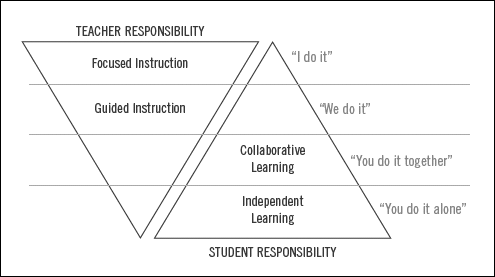Gradual Release of Responsibility

Indianola CSD uses an instructional model, based on the work of Douglas Fisher and Nancy Fry. The district continues to support this model through continual learning, modeling, and implementation. The goal of the Gradual Release of Responsibility Framework is to provide appropriate instruction, moving students towards independence. Importantly, the GRR Framework does not have to be linear. Based on instructional objectives, educators may appropriately choose to begin in any part of the framework. Students move back and forth between each of the components as they master skills, strategies, and standards.
Focus Lesson – During focus lessons, teachers lead instruction as students observe. Usually brief in nature, focus lessons engage students in learning by building and/or activating background knowledge, establishing/revisiting routines and expectations, establishing the purpose for learning, and providing a mini-lesson based on the standards. Teachers observe student engagement and use formative assessments to inform instruction.
Strategies to Launch a Focus Lesson:
- Read aloud
- Shared read/think aloud
- Model/demonstration
- Writing exemplars
Guided Instruction– Teachers guide instruction as students participate. Teachers observe student engagement and use formative assessments to inform instruction and provided students with feedback on their learning.
Strategies for Guided Instruction:
- Interrupted reading
- Echo reading
- Choral reading
- Guided reading
- Questions, prompts, and cues
Collaborative Learning – During collaborative learning, students use academic language as they work together to consolidate and apply their understanding of the content. Students are primarily responsible for their learning while teachers observe and provide support when needed. Collaborative learning should ensure both individual and group accountability. Teachers observe collaborative learning and use formative assessments and conferring to inform instruction, providing students with feedback on their learning.
Further Reading Strategies used in Collaborative Learning:
- Reciprocal teaching
- Partner read
- Productive group work
- Feedback
Independent Tasks – During independent tasks, students apply learning in new ways. In doing so, students synthesize information, transform ideas, and solidify their understanding. Students are primarily responsible for learning.
Strategies for Independent Tasks
- Mentor texts/exemplars
- Performance criteria, rubrics, and scoring guides
- Conferring
- Feedback
